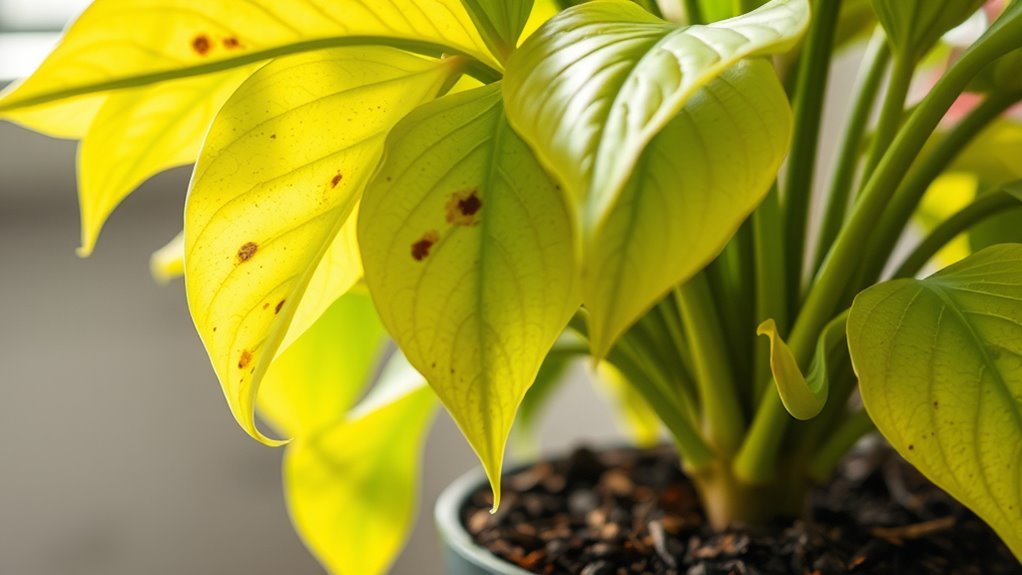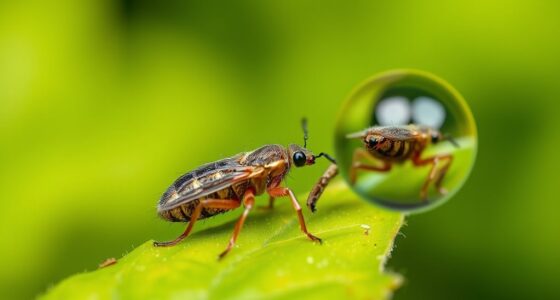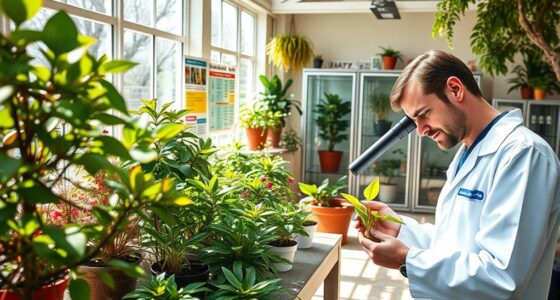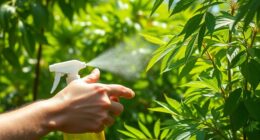To diagnose common plant problems, observe signs like yellowing or browning leaves, drooping stems, or dry, crispy foliage. Overwatering often causes root rot and foul smells, while underwatering leads to dry, brittle patches. Pest damage shows up as holes, sticky residue, or webbing. Changes in environment, like too much sun or too little light, can also stress your plant. Spotting these cues helps you find solutions—stick with it to learn more about keeping your plant healthy.
Key Takeaways
- Look for color changes like yellowing or browning leaves as signs of watering issues or nutrient deficiencies.
- Check soil moisture to distinguish between overwatering (soggy soil, foul smell) and underwatering (dry, crispy foliage).
- Inspect leaves and stems for pests, webbing, or holes to identify infestations affecting plant health.
- Observe environmental conditions; excessive sun or low light can cause discoloration or leggy growth.
- Notice symptoms like wilting, drooping, or dry foliage to diagnose water imbalance or stress signs.

When your plants start showing signs of trouble, diagnosing the problem quickly can save them from further damage. The first step is to observe their overall appearance and behavior carefully. Look for changes in color, texture, and growth patterns. These visual clues often point directly to specific issues, whether related to watering habits or pest identification. For example, yellowing leaves might suggest overwatering or poor drainage, while drooping stems could indicate underwatering. Recognizing these signs early allows you to adjust your care routine before the problem worsens. Additionally, understanding the importance of community resilience can help you seek advice from local gardening groups or experts to better diagnose complex issues. Watering habits are a common culprit behind many plant health issues. Overwatering can lead to root rot, which causes leaves to yellow, wilt, and sometimes develop a foul smell. Conversely, underwatering results in dry, crispy foliage and stunted growth. To determine if watering is the root cause, check the soil moisture by feeling the top inch or two. If it’s soggy, give the plant less water and ensure the pot has proper drainage. If the soil feels dry, increase watering frequency, but do so gradually to avoid shock. Establishing a consistent watering schedule suited to the plant’s needs is essential for maintaining healthy growth. Pest identification is equally important when diagnosing plant problems. Tiny insects or their residues—like webbing, sticky residue, or holes in leaves—are clear indicators of pests such as spider mites, aphids, or scale insects. These pests can weaken your plant, stunt growth, and make it more susceptible to disease. To identify pests, inspect the undersides of leaves and stems closely, using a magnifying glass if needed. Once identified, you can take targeted action, such as removing pests manually or applying an appropriate pesticide. Regularly checking your plants helps catch infestations early before they spread and cause extensive damage. Another aspect to consider is the environment your plant is in. Changes in temperature, light, or humidity can stress your plant and mimic pest or watering issues. For example, too much direct sunlight can scorch leaves, while too little light can cause leggy growth and pale leaves. Adjusting the placement of your plant and maintaining a stable environment can prevent these problems.
Frequently Asked Questions
How Often Should I Water My Plant?
You should establish a watering schedule based on your plant’s specific needs. Check moisture levels regularly—stick your finger an inch into the soil, and water when it feels dry. Overwatering can cause root rot, while underwatering stresses the plant. Adjust your watering frequency accordingly, typically once a week or when the soil dries out, to make certain your plant stays healthy and happy.
What’S the Ideal Sunlight for My Indoor Plant?
Did you know that 80% of indoor plants thrive with just bright, indirect sunlight? You should aim to provide your plant with the right light requirements by placing it near a window with filtered light or in a spot with consistent, gentle sunlight exposure. Avoid direct sunlight, which can scorch leaves, and make sure it gets enough light daily to stay healthy and vibrant.
How Can I Prevent Pests on My Plants?
To prevent pests on your plants, start with pest identification to catch issues early. Inspect your plants regularly and isolate any infested ones. Use organic pest control methods like neem oil or insecticidal soap, which are safe and effective. Keep your plants healthy with proper watering and sunlight, as strong plants resist pests better. Maintaining cleanliness and avoiding over-fertilizing also helps prevent pest outbreaks.
When Should I Repot My Plant?
You should repot your plant when it becomes root bound, meaning roots are circling the pot’s edges, or if it shows signs of overgrown roots, like stunted growth. Repotting also helps meet your plant’s fertilizer needs by providing fresh soil with nutrients. Typically, spring or early summer is best for repotting, giving your plant time to settle and grow in its new container.
What Soil Type Is Best for My Plant Species?
To choose the best soil for your plant, consider its specific needs. Look at its soil composition and drainage requirements; some plants thrive in well-draining, sandy soil, while others prefer more moisture-retentive mixes like peat or loam. You should match the soil type to your plant’s natural habitat and watering habits. Proper soil guarantees healthy growth and prevents issues like root rot or dehydration.
Conclusion
Now that you’ve spotted the signs, you’re well on your way to rescuing your plant. With a little patience and practice, you’ll confidently identify the issues, from wilting to yellowing. Remember, plant problems often come with telltale troubles—like trembling leaves or brown tips—that you can tackle. Trust your touch, tune into your plant’s signals, and turn trouble into triumph. Your green friends will thrive, thanks to your care and keen eye!









